Effects of Sn and Sb on the Hot Ductility of Nb+Ti Microalloyed Steels
Abstract
1. Introduction
2. Experimental
2.1. Experimental Materials
2.2. Experimental Methods
2.2.1. Thermal Expansion Test
2.2.2. High-Temperature Tensile Test
3. Results
3.1. Critical Transformation Point of Experimental Steels
3.2. Hot Ductility and Strength
4. Discussion
4.1. Stress–Strain Behavior
4.2. Influence of Precipitation on Hot Ductility
4.3. Fracture Morphology Analysis and Microstructure
4.4. Fracture Mechanism of the Lowest Brittle Valley
5. Conclusions
- (1)
- Sb steel and Sb+Sn steel did not show the first and second ductility trough in the experimental conditions and temperature range, and the third ductility trough is about 650–950 °C.
- (2)
- In the high-plasticity zone with the percentage reduction of area of Z > 60%, high temperature and deformation promote the occurrence of dynamic recrystallization, which is beneficial to the improvement of hot ductility. The third ductility trough, the pinning of the grain boundaries by fine precipitates and the precipitation of primary ferrite along the grain boundaries are responsible for the decrease in hot ductility.
- (3)
- The γ →α phase transition temperatures of Sb steel and Sb+Sn steel are 759 °C and 764 °C, respectively. The precipitates of the experimental steel are mainly TiN, Nb (C, N) not Sn and Sb. Adding a small amount of microalloying elements Sb and Sn does not affect the hot plasticity.
Author Contributions
Funding
Conflicts of Interest
References
- Sahoo, G.; Singh, B.; Saxena, A. Effect of strain rate, soaking time and alloying elements on hot ductility and hot shortness of low alloy steels. Mater. Sci. Eng. A 2018, 718, 292–300. [Google Scholar] [CrossRef]
- Ma, F.; Wen, G.; Wang, W. Effect of Cooling Rates on the Second-Phase Precipitation and Proeutectoid Phase Transformation of a Nb–Ti Microalloyed Steel Slab. Steel Res. Int. 2013, 84, 370–376. [Google Scholar] [CrossRef]
- Faccoli, M.; Roberti, R. Study of hot deformation behaviour of 2205 duplex stainless steel through hot tension tests. J. Mater. Sci. 2013, 48, 5196–5203. [Google Scholar] [CrossRef]
- Zhang, H.J.; Zhang, L.F.; Wang, Y.D. Effect of Sampling Locations on Hot Ductility of Low Carbon Alloyed Steels. Steel Res. Int. 2018, 89, 1800052. [Google Scholar] [CrossRef]
- Wang, Z.; Ma, W.; Wang, C. Effect of Strain Rate on Hot Ductility of a Duplex Stainless Steel. Adv. Mater. Sci. Eng. 2019, 2019, 6810326. [Google Scholar] [CrossRef]
- Yamamoto, K.; Yamamura, H.; Suwa, Y. Behavior of Non-metallic Inclusions in Steel during Hot Deformation and the Effects of Deformed Inclusions on Local Ductility. ISIJ Int. 2011, 51, 1987–1994. [Google Scholar] [CrossRef]
- Du, C.; Zhang, J.; Wen, J.; Li, Y.; Lan, P. Hot ductility trough elimination through single cycle of intense cooling and reheating for microalloyed steel casting. Ironmak. Steelmak. 2016, 43, 331–339. [Google Scholar] [CrossRef]
- Jang, J.H.; Heo, Y.U.; Lee, C.H.; Bhadeshia, H.K.D.H.; Suh, D.W. Interphase precipitation in Ti–Nb and Ti–Nb–Mo bearing steel. Mater. Sci. Technol. 2013, 29, 309–313. [Google Scholar] [CrossRef]
- Liu, Y.; Du, L.X.; Wu, H.Y.; Misra, R.D.K. Hot Ductility and Fracture Phenomena of Low-Carbon V–N–Cr Microalloyed Steels. Steel Res. Int. 2019, 91, 1900265. [Google Scholar] [CrossRef]
- Zhou, Q.; Li, Z.; Wei, Z.S.; Wu, D.; Li, J.Y.; Shao, Z.Y. Microstructural features and precipitation behavior of Ti, Nb and V microalloyed steel during isothermal processing. J. Iron Steel Res. Int. 2019, 26, 102–111. [Google Scholar] [CrossRef]
- Qian, G.; Cheng, G.; Hou, Z. Effect of the Induced Ferrite and Precipitates of Nb–Ti Bearing Steel on the Ductility of Continuous Casting Slab. ISIJ Int. 2014, 54, 1611–1620. [Google Scholar] [CrossRef]
- Lan, P.; Tang, H.; Zhang, J. Hot ductility of high alloy Fe–Mn–C austenite TWIP steel. Mater. Sci. Eng. A 2016, 660, 127–138. [Google Scholar] [CrossRef]
- Xie, Y.; Cheng, G.; Chen, L.; Zhang, Y.; Yan, Q. Characteristics and Generating Mechanism of Large Precipitates in Nb–Ti-microalloyed H13 Tool Steel. ISIJ Int. 2016, 56, 995–1002. [Google Scholar] [CrossRef]
- Vervynckt, S.; Verbeken, K.; Thibaux, P.; Houbaert, Y. Recrystallization–precipitation interaction during austenite hot deformation of a Nb microalloyed steel. Mater. Sci. Eng. A 2011, 528, 5519–5528. [Google Scholar] [CrossRef]
- Carpenter, K.R.; Dippenaar, R.; Killmore, C.R. Hot Ductility of Nb- and Ti-Bearing Microalloyed Steels and the Influence of Thermal History. Metall. Mater. Trans. A 2009, 40, 573–580. [Google Scholar] [CrossRef]
- Nam, N.D.; Kim, M.J.; Jang, Y.W.; Kim, J.G. Effect of tin on the corrosion behavior of low-alloy steel in an acid chloride solution. Corros. Sci. 2010, 52, 14–20. [Google Scholar] [CrossRef]
- Pardo, A.; Merino, M.C.; Carboneras, M.; Coy, A.E.; Arrabal, R. Pitting corrosion behaviour of austenitic stainless steels with Cu and Sn additions. Corros. Sci. 2007, 49, 510–525. [Google Scholar] [CrossRef]
- Park, S.A.; Kim, S.H.; Yoo, Y.H.; Kim, J.G. Effect of Chloride Ions on the Corrosion Behavior of Low-Alloy Steel Containing Copper and Antimony in Sulfuric Acid Solution. Met. Mater. Int. 2015, 21, 470–478. [Google Scholar] [CrossRef]
- Ahn, S.; Park, K.J.; Oh, K.; Hwang, S.; Park, B.; Kwon, H.; Shon, M. Effects of Sn and Sb on the Corrosion Resistance of AH 32 Steel in a Cargo Oil Tank Environment. Met. Mater. Int. 2015, 21, 865–873. [Google Scholar] [CrossRef]
- Pardo, A.; Merino, M.C.; Carboneras, M.; Viejo, F.; Arrabal, R.; Muñoz, J. Influence of Cu and Sn content in the corrosion of AISI 304 and 316 stainless steels in H2SO4. Corros. Sci. 2006, 48, 1075–1092. [Google Scholar] [CrossRef]
- Kameda, J.; Mcmahon, C.J. The effects of Sb, Sn, and P on the strength of grain boundaries in a Ni-Cr Steel. Metall. Trans. A 1981, 12, 31–37. [Google Scholar] [CrossRef]
- Liu, J.W.; Wang, C.M.; Yu, L.; Qi, Y.F. Hot Ductility of Q345B low carbon high strength steel. Nonferrous. Met. Sci. Eng. 2015, 6, 61–67. [Google Scholar]
- Song, W.X. Metal Science, 2nd ed.; Metallurgical Industry Press: Beijing, China, 1989; pp. 318–319. [Google Scholar]
- Chen, D.; Cui, H.; Wang, R. High-Temperature Mechanical Properties of 4.5%Al δ-TRIP Steel. Appl. Sci. 2019, 9, 5094. [Google Scholar] [CrossRef]
- Fu, J.; Wang, F.M.; Hao, F.; Jin, G.X. High-temperature mechanical properties of near-eutectoid steel. Int. J. Miner. Metall. Mater. 2013, 20, 829–834. [Google Scholar] [CrossRef]
- Zeng, Y.N.; Sun, Y.H.; Cai, K.K.; Ma, Z.F.; Xi, A. Failure mode and hot ductility of Ti-bearing steel in the brittle zone. Rev. Métall. 2013, 110, 315–323. [Google Scholar] [CrossRef]
- Mintz, B.; Jonas, J.J. Influence of strain rate on production of deformation induced ferrite and hot ductility of steels. Mater. Sci. Technol. 1994, 10, 721–727. [Google Scholar] [CrossRef]
- Lanjewar, H.A.; Tripathi, P.; Singhai, M.; Patra, P.K. Hot Ductility and Deformation Behavior of C-Mn/Nb-Microalloyed Steel Related to Cracking during Continuous Casting. J. Mater. Eng. Perform. 2014, 23, 3600–3609. [Google Scholar] [CrossRef][Green Version]
- Xie, S.S.; Lee, J.D.; Yoon, U.S.; Yim, C.H. Compression Test to Reveal Surface Crack Sensitivity between 700 and 1100 °C of Nb-bearing and High Ni Continuous Casting Slabs. ISIJ Int. 2002, 42, 708–716. [Google Scholar] [CrossRef]
- Mejía, I.; Bedolla-Jacuinde, A.; Maldonado, C.; Cabrera, J.M. Hot ductility behavior of a low carbon advanced high strength steel (AHSS) microalloyed with boron. Mater. Sci. Eng. A 2011, 528, 4468–4474. [Google Scholar] [CrossRef]
- Ghosh, S.; Mula, S. Fracture toughness characteristics of ultrafine grained Nb–Ti stabilized microalloyed and interstitial free steels processed by advanced multiphase control rolling. Mater. Charact. 2020, 159, 110003. [Google Scholar] [CrossRef]
- Sakai, T.; Jonas, J.J. Dynamic recrystallization: Mechanical and microstructural considerations. Acta. Metal. 1984, 32, 189–209. [Google Scholar] [CrossRef]
- Ryan, N.D.; Mcqueen, H.J. Flow stress, dynamic restoration, strain hardening and ductility in hot working of 316 steel. J. Mater. Process. Technol. 1990, 21, 177–199. [Google Scholar] [CrossRef]
- Mirzadeh, H.; Najafizadeh, A. Prediction of the critical conditions for initiation of dynamic recrystallization. Mater. Des. 2010, 31, 1174–1179. [Google Scholar] [CrossRef]
- Poliak, E.I.; Jonas, J.J. Initiation of Dynamic Recrystallization in Constant Strain Rate Hot Deformation. ISIJ Int. 2007, 43, 684–691. [Google Scholar] [CrossRef]
- Kim, S.I.; Lee, Y.; Byon, S.M. Study on constitutive relation of AISI 4140 steel subject to large strain at elevated temperatures. J. Mater. Process. Technol. 2003, 140, 84–89. [Google Scholar] [CrossRef]
- Matveev, M.A.; Kolbasnikov, N.G.; Kononov, A.A. Causes of High Temperature Ductility Trough of Microalloyed Steels. Trans. Indian Inst. Met. 2017, 70, 2193–2204. [Google Scholar] [CrossRef]
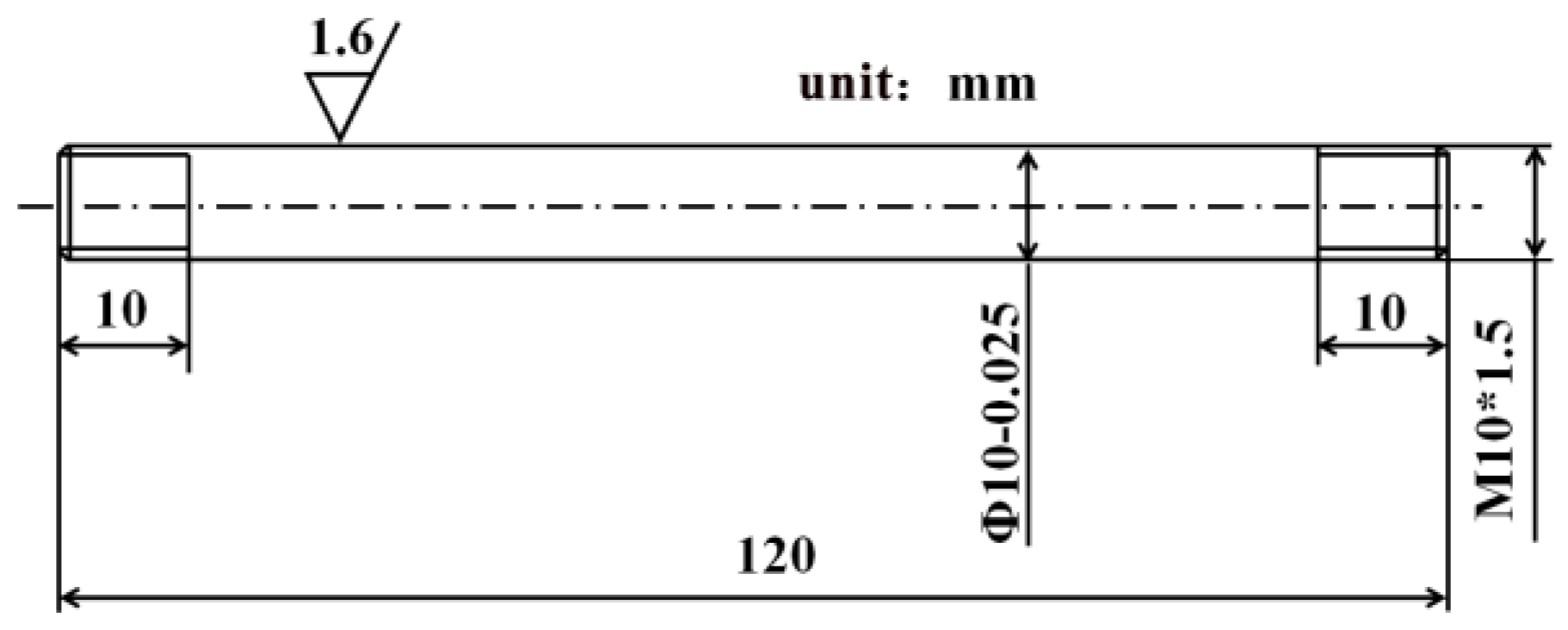
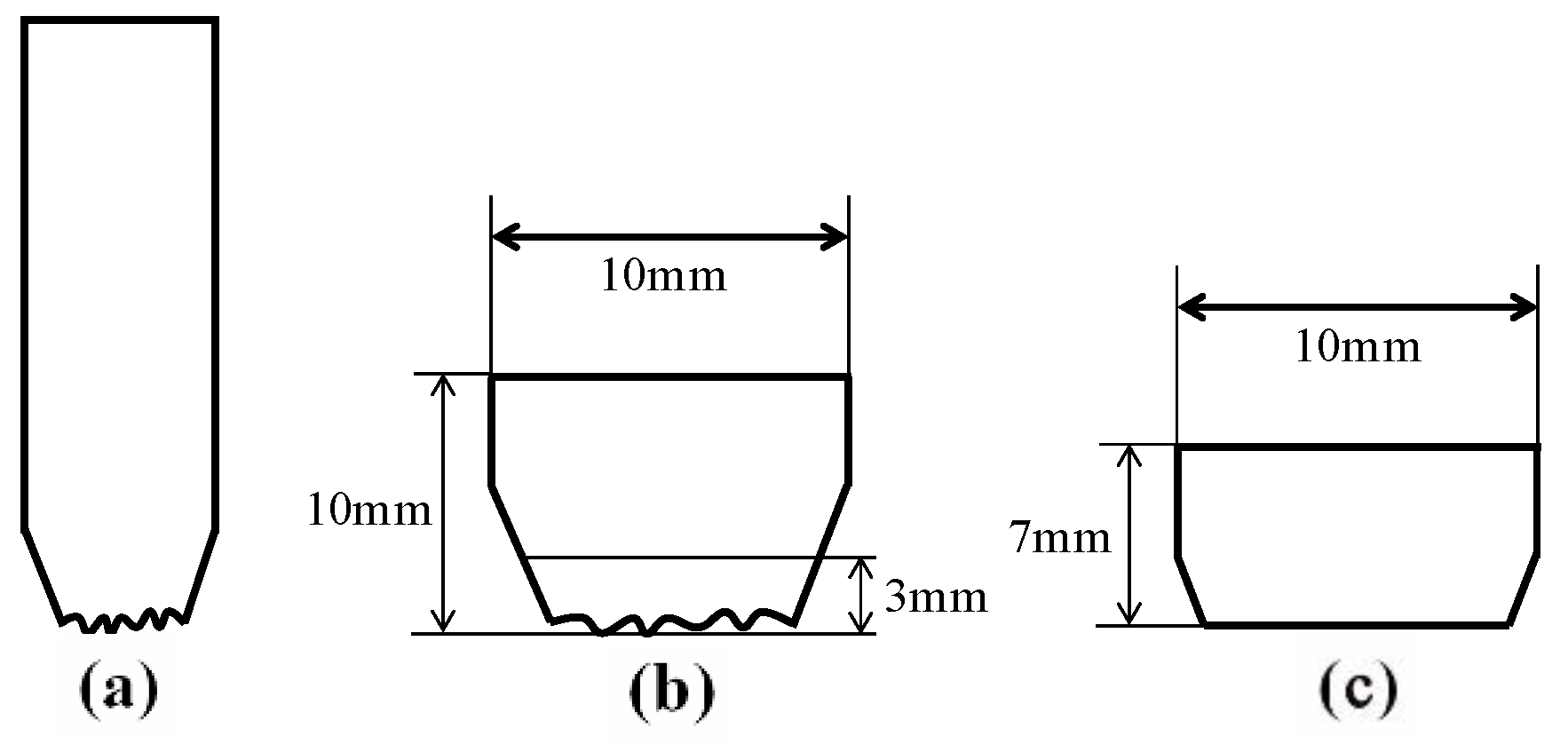
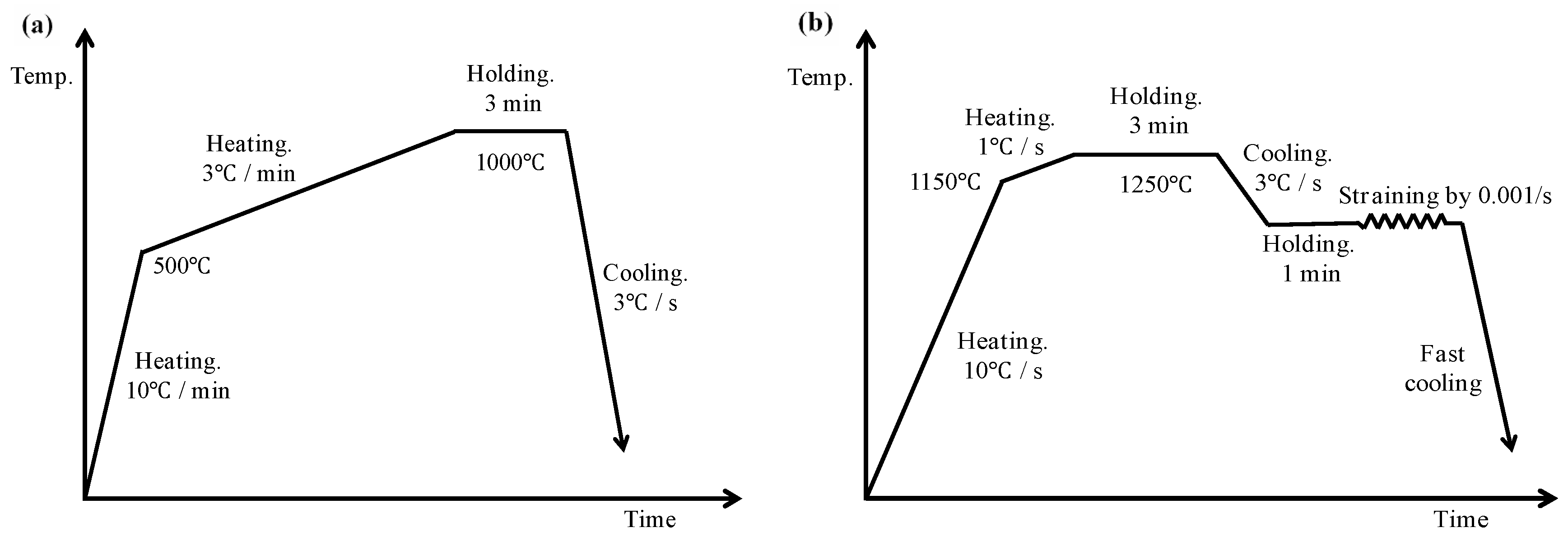
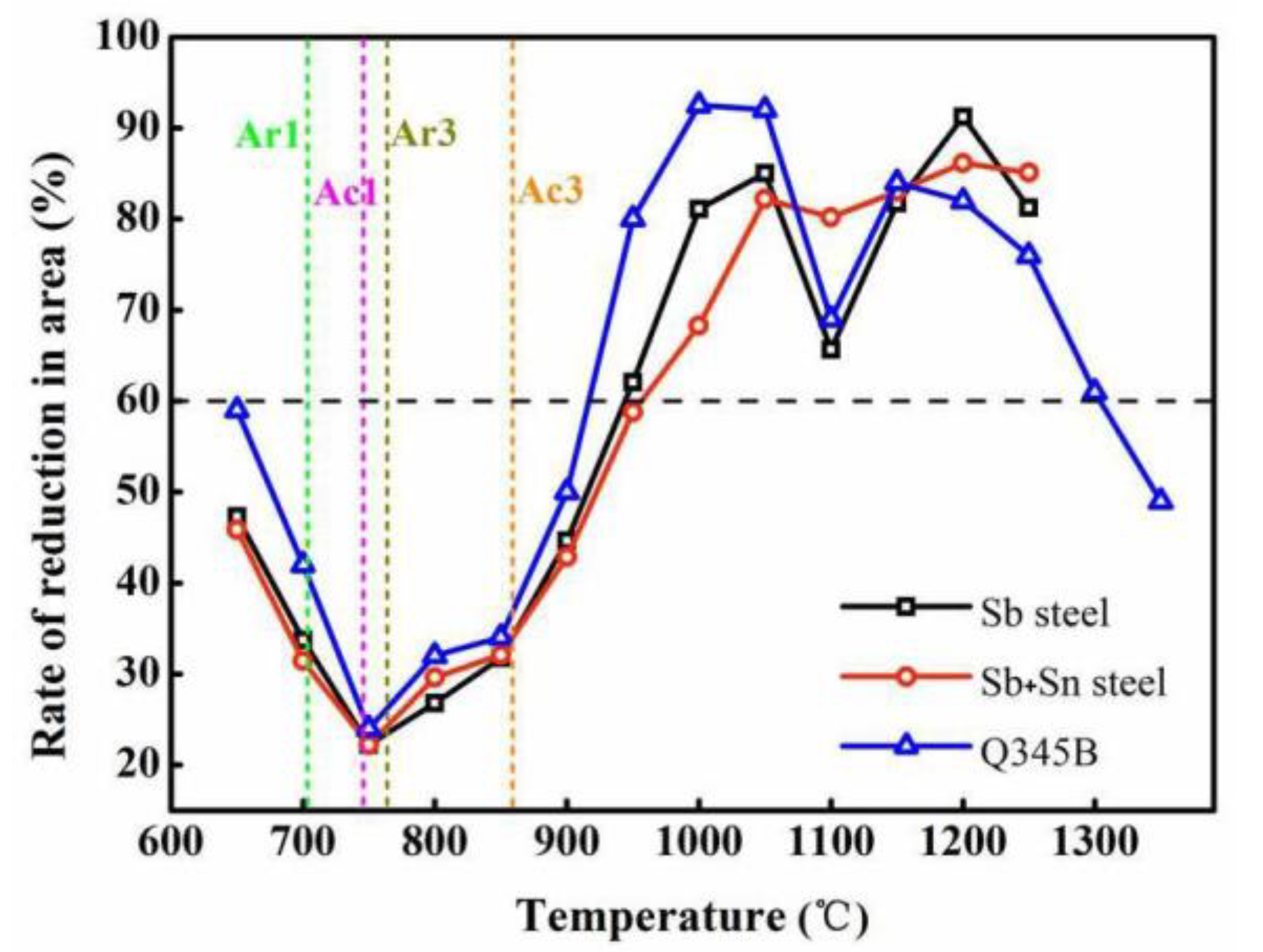

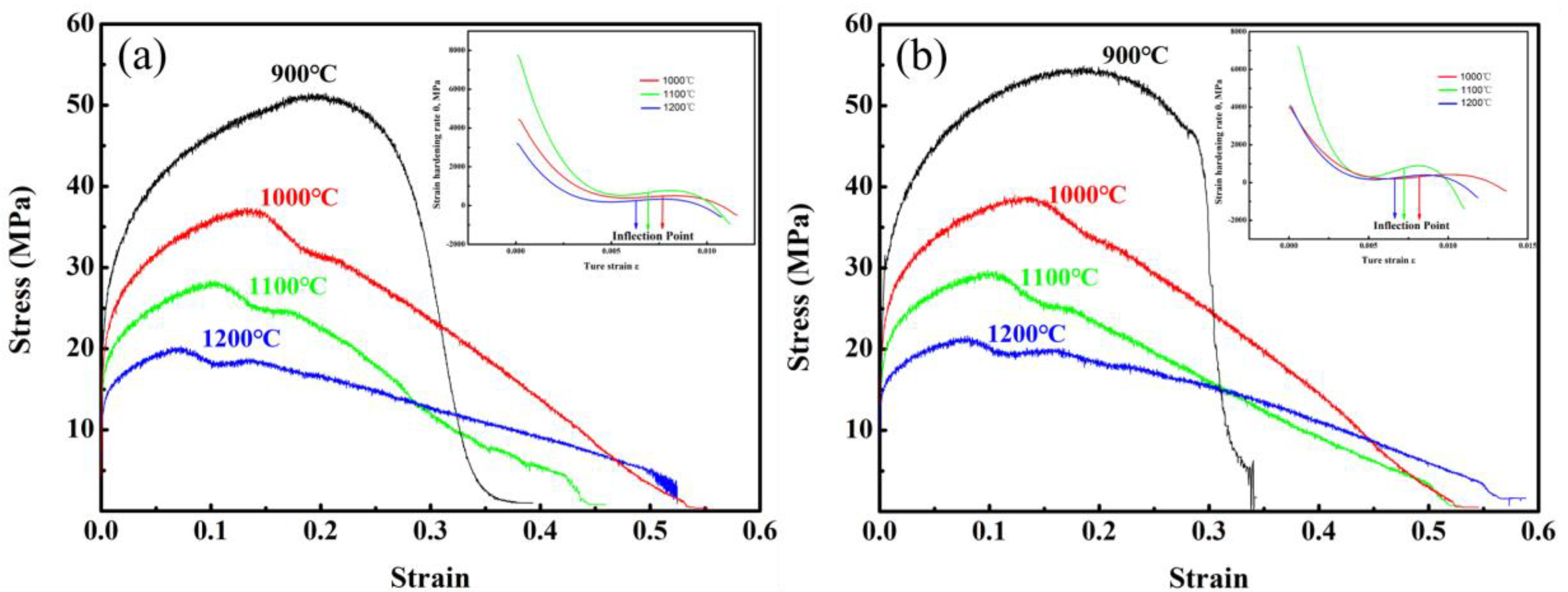

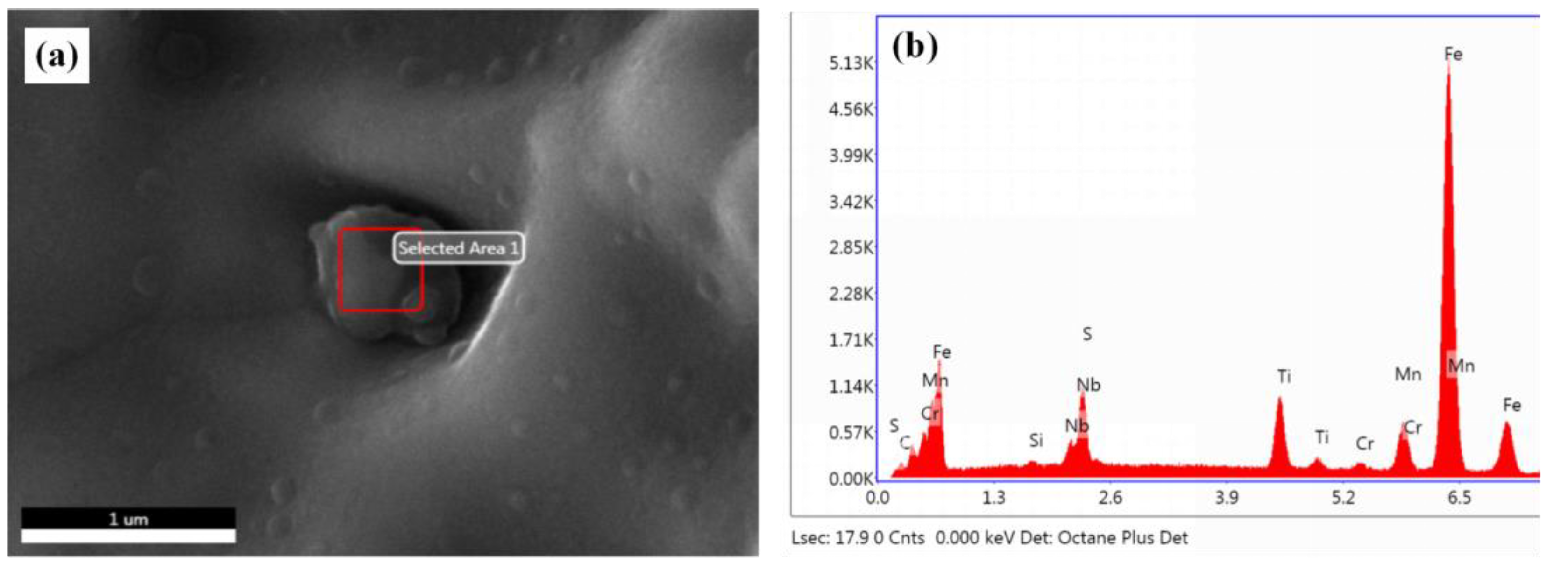

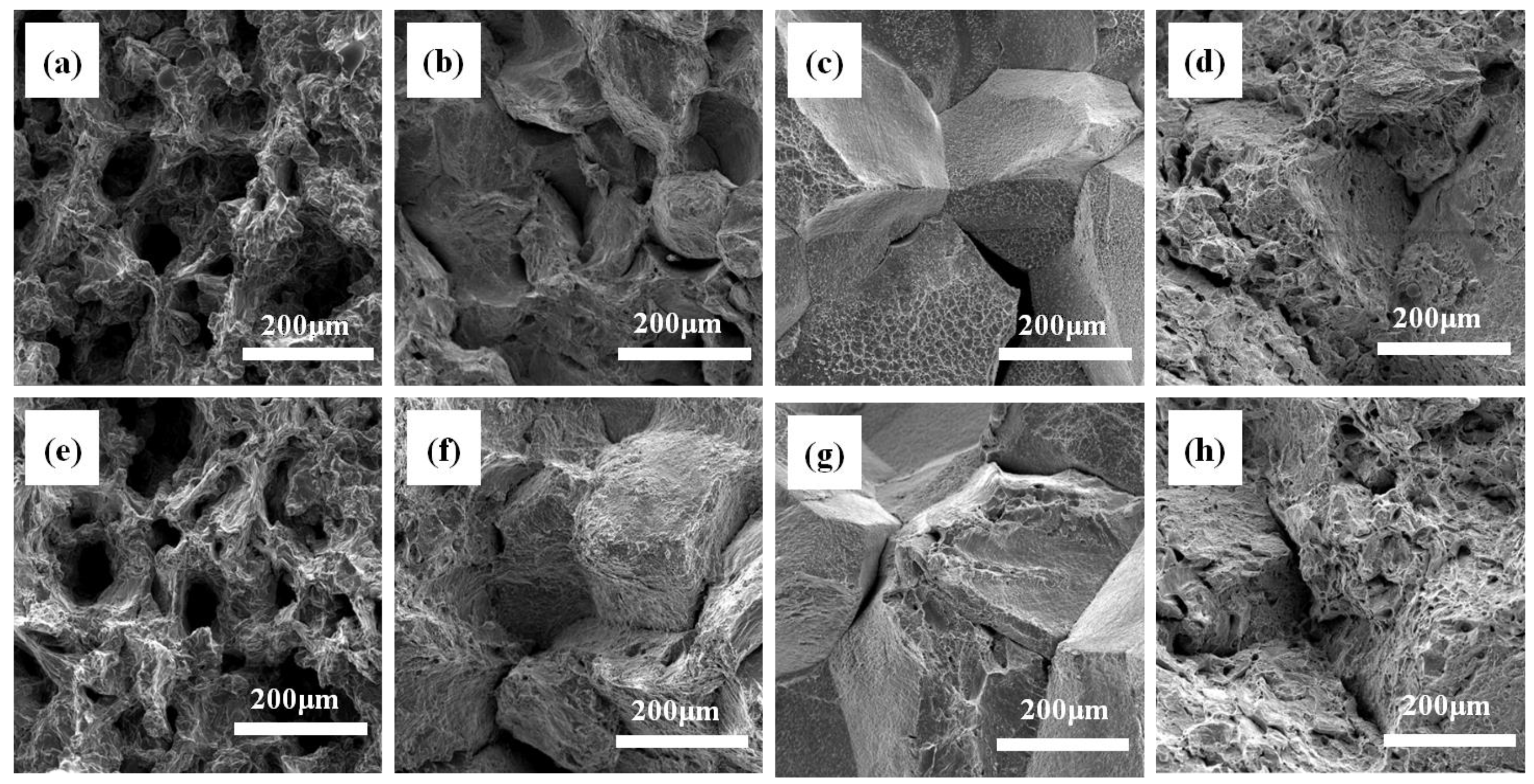

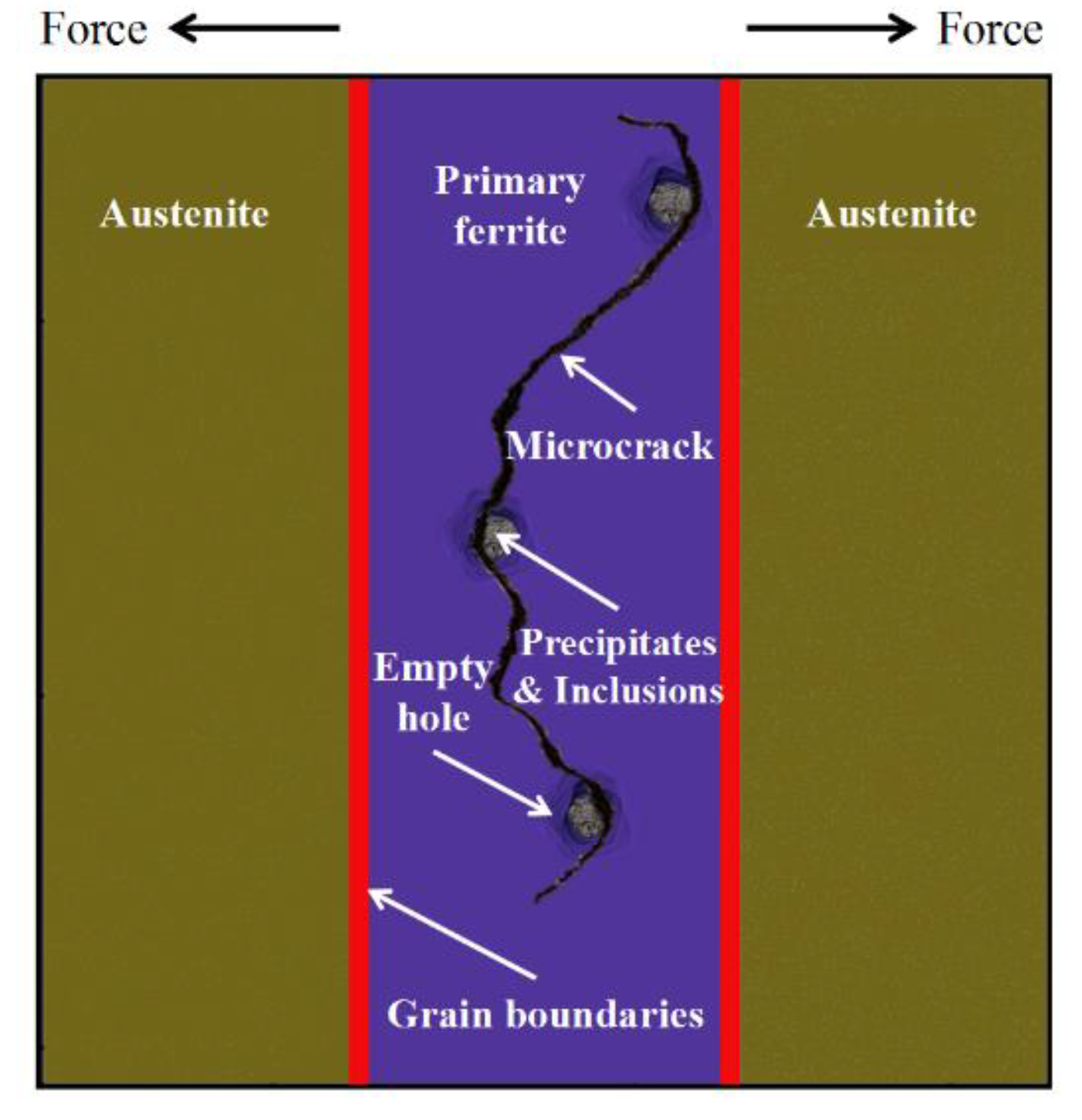
| Steel | C | Si | Mn | S | P | Cu+Cr+Ni | Sn | Sb | Al | Nb | Ti | N |
|---|---|---|---|---|---|---|---|---|---|---|---|---|
| Sb+Sn steel | 0.062 | 0.25 | 0.89 | 0.003 | 0.003 | 1.5–1.9 | 0.043 | 0.050 | 0.039 | 0.026 | 0.004 | |
| Sb steel | 0.083 | 0.26 | 0.91 | 0.006 | 0.003 | 1.5–1.9 | 0.050 | 0.044 | 0.025 | 0.004 | ||
| Q345B | 0.17 | 0.193 | 1.438 | 0.015 | 0.018 | 0.028 | 0.025 | 0.012 | 0.004 |
Publisher’s Note: MDPI stays neutral with regard to jurisdictional claims in published maps and institutional affiliations. |
© 2020 by the authors. Licensee MDPI, Basel, Switzerland. This article is an open access article distributed under the terms and conditions of the Creative Commons Attribution (CC BY) license (http://creativecommons.org/licenses/by/4.0/).
Share and Cite
He, C.; Wang, J.; Chen, Y.; Yu, W.; Tang, D. Effects of Sn and Sb on the Hot Ductility of Nb+Ti Microalloyed Steels. Metals 2020, 10, 1679. https://doi.org/10.3390/met10121679
He C, Wang J, Chen Y, Yu W, Tang D. Effects of Sn and Sb on the Hot Ductility of Nb+Ti Microalloyed Steels. Metals. 2020; 10(12):1679. https://doi.org/10.3390/met10121679
Chicago/Turabian StyleHe, Chunyu, Jianguang Wang, Yulai Chen, Wei Yu, and Di Tang. 2020. "Effects of Sn and Sb on the Hot Ductility of Nb+Ti Microalloyed Steels" Metals 10, no. 12: 1679. https://doi.org/10.3390/met10121679
APA StyleHe, C., Wang, J., Chen, Y., Yu, W., & Tang, D. (2020). Effects of Sn and Sb on the Hot Ductility of Nb+Ti Microalloyed Steels. Metals, 10(12), 1679. https://doi.org/10.3390/met10121679





